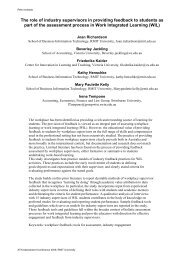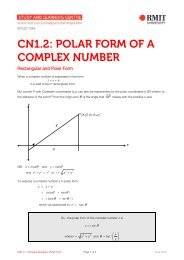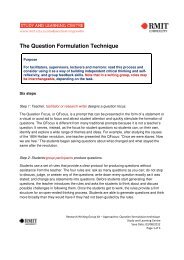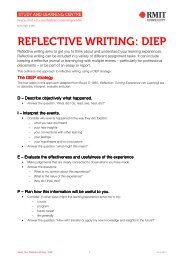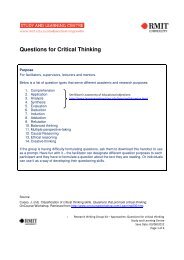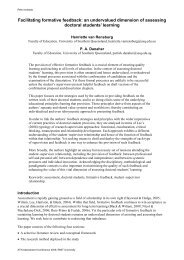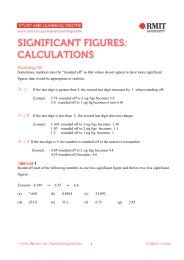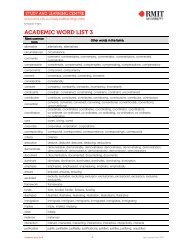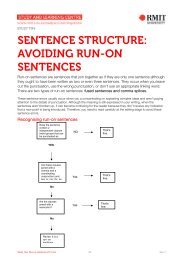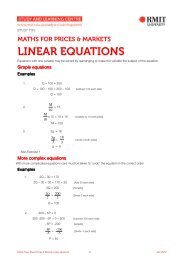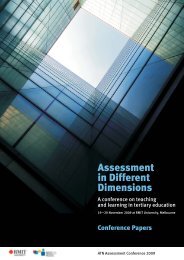student feedback and leadership - Office for Learning and Teaching
student feedback and leadership - Office for Learning and Teaching
student feedback and leadership - Office for Learning and Teaching
Create successful ePaper yourself
Turn your PDF publications into a flip-book with our unique Google optimized e-Paper software.
Part B: Building Leadership Capacity - BUS: School of Economics, Finance & Marketing ART Report<br />
Students are expected to attend a three hour lecture each week that usually<br />
runs <strong>for</strong> approximately two to two <strong>and</strong> a half hours with the remainder time set<br />
aside <strong>for</strong> <strong>student</strong>s to ask questions. During lectures, basic economic theories<br />
are presented to <strong>student</strong>s in each module with application questions scattered<br />
throughout the lecture presentation to indicate the type of problems that will<br />
be presented in the final exam <strong>and</strong> the calibre of answers required. Students<br />
are also required to attend a two hour <strong>feedback</strong> <strong>for</strong>um each week, in which<br />
they are given the opportunity to apply the theoretical principles to the real<br />
economy through weekly assessment.<br />
ECON1020 – Prices <strong>and</strong> Markets<br />
Prices <strong>and</strong> Markets is a study of microeconomic theory <strong>and</strong> its applications.<br />
The course focuses on how individual consumers <strong>and</strong> firms behave, the<br />
functioning of the markets within which they operate, <strong>and</strong> in particular how<br />
prices are determined. The purpose of the course is to enable <strong>student</strong>s<br />
to acquire the basic analytical tools needed to underst<strong>and</strong> the working<br />
of the micro economy. On completing the course, <strong>student</strong>s should have<br />
some underst<strong>and</strong>ing of the basic microeconomic problems facing society,<br />
the interaction of dem<strong>and</strong> <strong>and</strong> supply in the market place, the nature <strong>and</strong><br />
relevance of various costs facing firms, pricing policies <strong>and</strong> profit maximising<br />
conditions relevant to various market structures. They should also have<br />
an awareness of the possible causes of market failure <strong>and</strong> the role of the<br />
government <strong>and</strong> be able to apply simple microeconomic theory to some<br />
practical problems.<br />
Students are expected to attend a two hour lecture <strong>and</strong> a two hour demonstration<br />
lecture each week. Discussion of the material in the demonstration lecture<br />
each week should take no more than 1.5 hours, leaving time <strong>for</strong> <strong>student</strong>s<br />
to obtain individual assistance from the lecturer at the end of the class.<br />
What were the central themes or issues being addressed in the project?<br />
Consistent with the larger ALTC project, the key focus of our ART project<br />
was to analyse, evaluate <strong>and</strong> explore different <strong>for</strong>ms of <strong>feedback</strong> received from<br />
<strong>student</strong>s to better underst<strong>and</strong> how we might continue to improve the learning<br />
experience in these courses. Based on this <strong>feedback</strong>, several initiatives were<br />
developed <strong>and</strong> implemented with the aim of enhancing the <strong>student</strong> learning<br />
experience. The Common Core courses were an appropriate focus <strong>for</strong> our<br />
project <strong>for</strong> the following reasons:<br />
––<br />
the large <strong>student</strong> numbers <strong>and</strong> the associated logistical challenges;<br />
––<br />
the diverse <strong>student</strong> background in terms of chosen disciplines;<br />
––<br />
the importance of these courses within the Business College <strong>and</strong> each<br />
of its undergraduate programs;<br />
––<br />
the unique challenges associated with <strong>student</strong>s transitioning from<br />
school; <strong>and</strong><br />
––<br />
the resources dedicated to each course.<br />
Page 91



